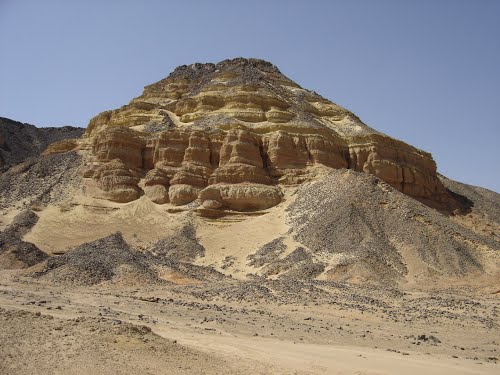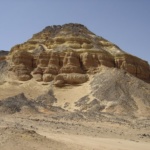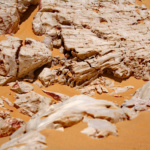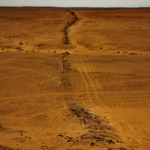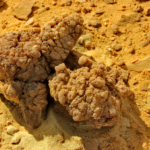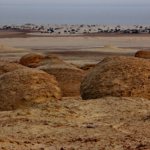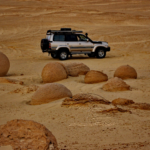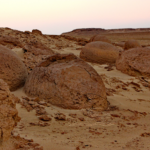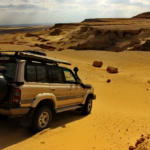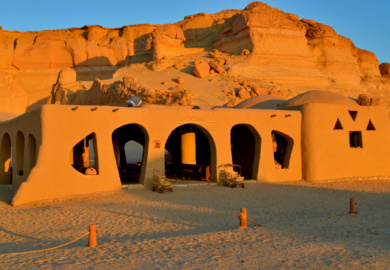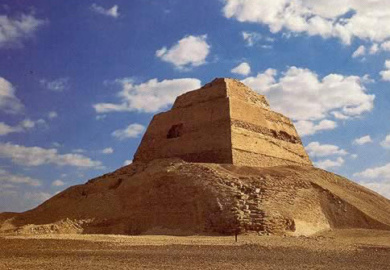Qatrani Mountain
Fond of hiking? Fayoum has a trail for you. Authentic desert adventure? Qatrani mountain which is a 350 meters high sandstone mountain and a major landmark for travellers and hikers in Fayoum.
Jebel Qatrani OPEN AIR museum is located inside the Petrified Forest area; north of Lake Qaroun a few kilometers from Jebel Qatrani and the ancient basalt quarries. The museum was built early 2018 and yet to be inaugurated soon. It is showcasing fossils of both marine (started in Eocene with the fossil ancestors of Archaeocetes: whales) and continental (with the fossil ancestors of monkeys: Aegyptopithecus; elephants: Phiomia, Palaeomastodon, Arsinoitherium); and several other terrestrial and marshland mammals. It is showing the variety of vertebrate fossil mammals in the world in terms of fossil quality and preservation values.
The Museum was built by (SUPPORT TO THE EGYPTIAN PROTECTED AREAS (SEPA) PROJECT) and reflects the outstanding universal value of Jebel Qatrani site and will positively impact the Eco tourism industry in Fayoum.
The site of Jebel Qatrani is proposed to be inscribed under natural criterion viii of the operational guidelines for World Heritage 2005. The nature conservation sector of the ministry of Environment identifies the Jebel Qatrani as a fossil site of major importance from the scientific point of view and one of the most important sites in the whole African continent in terms of fossil richness in its management plan.
The Jebel Qatrani area is a treasure trove of fossils that tells the story of the evolution of mammals and primates, starting in the Eocene, notably the ancestry of elephants, hippopotami, hyraxes, lemuroids, monkeys, and anthropoids in addition to multiple representatives of extinct mammalian orders (Embrithopoda, Ptolemaiida) and noteworthy fossil plants.
The Jebel Qatrani area of northern Egypt preserves the richest terrestrial mammal bearing Paleogene exposures in Egypt, if not the entire Afro-Arabian landmass (Sieffert, 2012). Unlike any other known fauna, living or extinct, the mammal community of the JQ consisted of a mixture of endemic groups that have now become extinct or greatly reduced in diversity, plus some important immigrant groups from Eurasia.
The site gives evidence on the migration of animals from Africa to Australia and Asia through the occurrence of the genus Varanus; the fossils come from late Eocene and early Oligocene freshwater deposits of JQ site, Egypt. The recovery and identification of this material indicate that the genus Varanus arose in Africa, before dispersing to Australia and Asia Fluvial deposits of the early oligocene age of the JQ site in Egypt documents the earliest known diverse avifauna from Africa, comprising at least 13 families and 18 species; this Oligocene avian fauna resembles that of modern tropical African assemblages.
The habitat preferences of the constituent species of birds indicate a tropical, swampy, vegetation-choked, fresh-water environment at the time of deposition.
Jebel Qatrani fossil site is the only location that compromises two major Paleogene fossils intervals: late Eocene (37-33.9) MYA and early Oligocene (33.9-28,5) MYA.
Eocene and Oligocene rocks in the Jebel Qatrani Fossil area are the richest in fossils among all sites. A few fossil species are very limited in numbers; especially some primates, and some species of even-toed mammals are very abundant.
The site had the best preservation of Eocene/Oligocene fauna and flora and the largest fossil collections (more than 385 thousand mammals’ jaws, 11500 skulls and 46 thousand mammals bones); the fossils record in Jebel Qatrani presents 12 order of placental mammals from the 28 exist today.
Among the most important exhibits in the Museum are;
Arsinoitherium: Arsinoe beast ( Fayoum Animal ) was named after Queen Arsinoe of Ancient Egypt. This beast was 1.8 meters high at the shoulder and 3 meters long with a pair of enormous horns above the nose and a second pair of tiny knobs like horns over eyes. The two large horns on their snouts were hollow and possibly used to produce loud mating calls as well as to compete with rival males. This hefty creature probably spent much of its day chewing on fruits and leaves. Its large size kept it safe from most predators, although creodonts might tackle young individuals.
Arsinoitherium lived in small groups and would have been in the water most of the time; it was more closely related to elephants and sea cows than it was rhinos. The complete skeletons of its fossils were recovered from the north of Lake Qaroun by Beadnell in 1902.
Aegyptopithecus: 30 million years ago Aegyptopithecus ( or the Egyptian Monkey) was a tree- dwelling primate that lives in a swampy forest with a great density of other mammals. This early monkey’s weight is estimated at around 6 kilograms; and it ate primarily fruits and showed sexual dimorphism, with males larger and having bigger canines. The enlarged canines served to scare or bite competing males.
Aegyptopithecus is widely believed to be near the ancestral line of old world monkeys and the hominoids (humans and apes). It was discovered by Elwyn Simons in 1965 from Quarry M in Jebel Qatrani formation a few kilometers from the Open air Museum.

